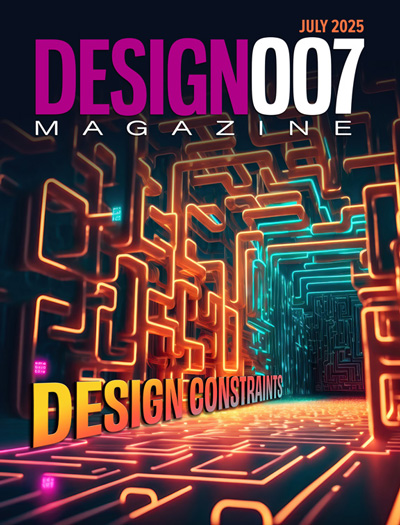-

- News
- Books
Featured Books
- design007 Magazine
Latest Issues
Current Issue
Proper Floor Planning
Floor planning decisions can make or break performance, manufacturability, and timelines. This month’s contributors weigh in with their best practices for proper floor planning and specific strategies to get it right.

Showing Some Constraint
A strong design constraint strategy carefully balances a wide range of electrical and manufacturing trade-offs. This month, we explore the key requirements, common challenges, and best practices behind building an effective constraint strategy.

All About That Route
Most designers favor manual routing, but today's interactive autorouters may be changing designers' minds by allowing users more direct control. In this issue, our expert contributors discuss a variety of manual and autorouting strategies.
- Articles
- Columns
- Links
- Media kit
||| MENU - design007 Magazine
Electronic Design Automation Market to Reach $17.47 Billion by 2030, Growing at a CAGR of 10.7%
March 31, 2025 | PRNewswireEstimated reading time: 4 minutes
According to a new market research report titled 'Electronic Design Automation Market Size, Share, Forecast & Trends Analysis by Offering (Solutions, Services), Deployment Mode (On-premise, Cloud-based), Tool Type (Design Tools, Verification Tools, Simulation Tools), and Geography – Global Forecast to 2030', published by Meticulous Research®, the global Electronic Design Automation (EDA) market is expected to grow from an estimated $8.96 billion in 2023 to $17.47 billion by 2030, at a CAGR of 10.7% during the forecast period.
Key Market Drivers and Trends
The growth of the EDA market is driven by the increasing complexity of integrated circuit (IC) designs, rising adoption of connected devices, and growing demand for EDA solutions in the aerospace and defense sectors. Additionally, the increasing integration of AI and machine learning in chip design is further boosting market expansion.
Cloud-based EDA solutions are gaining traction as companies seek cost-effective and scalable alternatives to traditional on-premise deployments. The ability to access design tools remotely, collaborate in real-time, and leverage cloud computing power is accelerating adoption across small and mid-sized enterprises (SMEs).
Growth Opportunities
The rapid evolution of AI and ML-based EDA tools is expected to create new growth opportunities. These advanced tools enhance automation, reduce design time, and improve performance, increasing efficiency in semiconductor and electronics manufacturing. Additionally, the growing demand for edge computing and high-performance computing (HPC) chips is driving the need for more sophisticated and automated EDA solutions.
The increasing adoption of cloud-based solutions is another major growth driver, enabling seamless collaboration and improved accessibility for global design teams. Companies are increasingly integrating AI and ML algorithms into their workflows to optimize design accuracy and efficiency, reducing costly errors and accelerating time-to-market. Moreover, the emergence of domain-specific electronic product designs and the rising focus on power-efficient chipsets for IoT and AI applications are expected to drive innovation in EDA solutions. Increased investments in R&D and strategic collaborations between semiconductor companies and EDA solution providers will further expand market potential.
Market Challenges
Despite strong growth potential, the EDA market faces several challenges. High software costs remain a major barrier, particularly for small and mid-sized companies looking to adopt advanced design tools. Licensing fees and maintenance costs can be substantial, limiting accessibility for smaller market players.
Another key challenge is the availability of open-source EDA tools, which, while cost-effective, lack the full-scale capabilities of premium solutions. As a result, companies must balance cost efficiency with performance when selecting EDA tools.
The rapid technological evolution of semiconductor manufacturing processes creates challenges in keeping EDA tools up to date. As chip designs become more complex, ensuring seamless compatibility between hardware and software tools is becoming increasingly difficult. Additionally, concerns regarding data security in cloud-based EDA deployments continue to hinder widespread adoption, especially in highly regulated industries like aerospace and defense. The industry also faces a shortage of skilled professionals with expertise in advanced EDA tools, further complicating adoption and implementation.
Segment Insights:
By Offering: The solutions segment dominates the market, accounting for approximately 72.4% of the share in 2023, driven by increasing investments in advanced IC design, verification, and semiconductor IP solutions. The services segment is anticipated to register the highest CAGR, as organizations seek expert consulting, training, and implementation support to enhance their EDA workflows.
By Deployment Mode: Cloud-based EDA solutions are expected to register the highest CAGR, with companies shifting towards flexible and cost-efficient design environments. Cloud-based deployment offers improved accessibility, real-time collaboration, and scalable computing power, making it an attractive choice for semiconductor manufacturers and electronics design firms.
By Tool Type: Design tools are the largest segment, accounting for 48.5% of the market share in 2023, due to growing complexity in ICs, printed circuit boards (PCBs), and semiconductor design processes. Verification tools are also seeing significant growth, driven by the increasing need to ensure chip reliability and performance before mass production.
Regional Analysis:
The Asia-Pacific region is expected to register the highest CAGR in the global electronic design automation market during the forecast period. The increasing presence of semiconductor foundries in China, Taiwan, South Korea, and Japan, coupled with rising investments in AI-driven chip design, is fueling market expansion in the region. Governments in these countries are also providing incentives to boost domestic semiconductor production, further driving demand for EDA solutions.
North America remains a dominant market due to the presence of major semiconductor manufacturers and EDA solution providers. The region's strong focus on R&D, coupled with high adoption rates of advanced design automation technologies, is sustaining steady growth. Europe is also witnessing a rise in EDA adoption, particularly in the automotive and aerospace industries, where the demand for high-performance and reliable chips is growing.
Competitive Insights
The global EDA market is highly competitive, with key players focusing on AI-powered solutions, strategic partnerships, and innovative product launches. Leading companies include Cadence Design Systems, Inc. (U.S.), Synopsys, Inc. (U.S.), Siemens AG (Germany), ANSYS, Inc. (U.S.), Keysight Technologies, Inc. (U.S.), Altium Limited (U.S.), Zuken (Japan), and Silvaco, Inc. (U.S.).
Recent Industry Developments
- March 2024: Cadence Design Systems launched an AI-driven chip optimization tool to improve design automation.
- January 2024: Synopsys acquired a semiconductor AI startup to enhance its ML-powered design verification tools.
- October 2023: Siemens EDA announced a partnership with a leading semiconductor foundry to streamline chip design processes.
Testimonial
"Advertising in PCB007 Magazine has been a great way to showcase our bare board testers to the right audience. The I-Connect007 team makes the process smooth and professional. We’re proud to be featured in such a trusted publication."
Klaus Koziol - atgSuggested Items
Automation Meets Sustainability
09/08/2025 | Rick Nichols, GreenSource EngineeringGreenSource Engineering (GSE) is proud to have contributed to the first successful reshoring of a PCB facility on a greenfield site in the United States. While we are honored to have played a key role, full credit for this achievement goes to SEL for its vision, commitment, and professionalism.
Cadence to Acquire Hexagon’s Design & Engineering Business
09/08/2025 | Cadence Design SystemsCadence announced it has entered into a definitive agreement to acquire the Design & Engineering (D&E) business of Hexagon AB, which includes its MSC Software business—a pioneer in engineering simulation and analysis solutions.
Synopsys, GlobalFoundries Establish Pilot Program to Bring Chip Design and Manufacturing to University Classrooms
09/05/2025 | GlobalFoundriesSynopsys, Inc. and GlobalFoundries (GF) announced a new collaboration to launch an educational ‘chip design to tapeout’ program for universities worldwide.
I-Connect007 Editor’s Choice: Five Must-Reads for the Week
09/05/2025 | Andy Shaughnessy, I-Connect007It’s almost fall here in Atlanta, and that means that the temperature is finally dropping. And it quit raining! It’s been raining since March, and I’m so over it, as the social influencers say. Last night we grilled out on the deck, and it wasn’t hot, and we didn’t get rained on. Life is good. It was a busy week in the industry. In this installment of my must-reads, we say goodbye to Walt Custer, the man who made PCB data points interesting for the rest of us.
American Standard to Participate in European Microwave Week 2025
09/05/2025 | American Standard CircuitsAnaya Vardya, President, and CEO of American Standard Sunstone Circuits has announced that his company will once again be taking part in European Microwave Week, Europe’s premier RF, microwave, radar and wireless event, to be held from September 21-26, 2025 at Jaarbeurs in Utrecht, The Netherlands.


